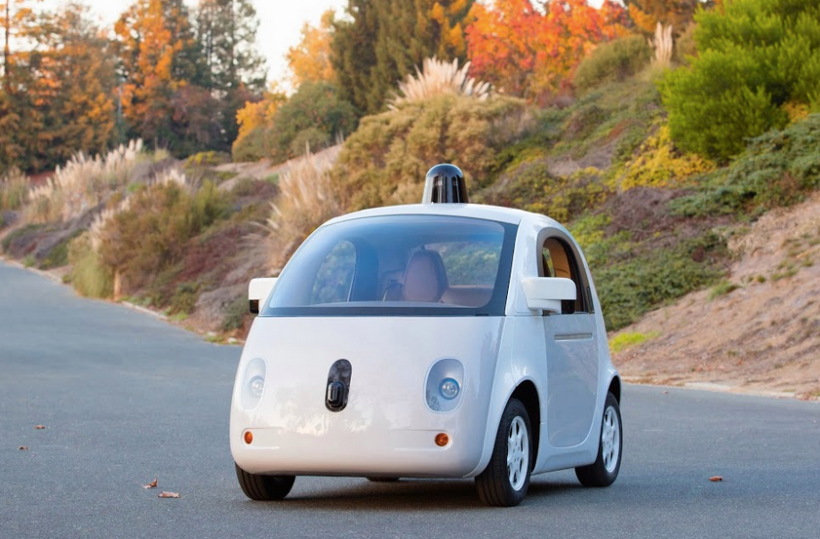
Hot off the presses! (Credit: Google)
If you're more of a "I love to stare out the window while Ani Difranco ravages my stereo" kind of driver than a "can you feel the smooth acceleration of the German-made titanium transmission" driver—or if you find the whole driving thing a rather anxious blur of yellow lines soaked in the dull stench of exhaust—then have we got news for you!

While the latest iteration still looks like a glorified gumdrop, there are a few additions and changes that the geek-patrol are taking note of, including the tweaking of the grill, which makes the new prototype look decidedly less like a wincing cartoon beetle; the presence of headlights and reflectors (mighty useful); and a tweaking of the sensors, so they now look like police siren cum-bubbles rather than tiny oil rigs.
In addition to being a sci-fi wet dream (or, alternatively, a "don't let the robots get us" nightmare), these self-driving cars also represent a huge step in eliminating human error; more than 1.2 million people die every year from car crashes globally.
"I think it has the potential to be the most important safety technology that the auto industry has ever seen," Ron Medford, former deputy director of the US Highway Safety Administration told the BBC.

Conversely, one needs only to pause to consider the potentially stomach-churning, I Robot-esque fallout. In a Wired piece, ethicist Patrick Lin and engineer Jason Miller mused about having to ethically program these pending cars to "react" the way we would, should we be faced with some harrowing choice like The Tunnel Problem:
"You are traveling along a single-lane mountain road in an autonomous car that is fast approaching a narrow tunnel. Just before entering the tunnel a child errantly runs into the road and trips in the centre of the lane, effectively blocking the entrance to the tunnel. The car is unable to brake in time to avoid a crash. It has but two options: hit and kill the child, or swerve into the wall on either side of the tunnel, thus killing you. Now ask yourself, Who should decide whether the car goes straight or swerves? Manufacturers? Users? Legislators?"
Both Lin and Miller point to a recent study by Open Roboethics Initiative in which participants were confronted with these very quandaries. It revealed that 77% of respondents felt users or legislators should "make the call." It's heady stuff and there's no simple answer—and Google sure isn't tackling it at this current juncture. In fact, they are fare more focused on how quickly they can get these cars on the highways and byways.
Despite their growing momentum in the car industry, Google explains that no, it's not pivoting its business model and entering car manufacturing (rats!), but it does want to jumpstart a "pilot program" that would encourage the development of regulations in conjunction with California's DMV for the operational use of driverless cars.
Currently there is nothing short of a morass of legislation to wade through and figure out; basically it's a classic case of Catch 22. The DMV says they're happy to sign off on the self-driving cars as soon as their safety can be proven. The trouble is, there are currently no accepted safety standards to verify said safety.
The DMV has three options in what rules it could implement: It could "follow the current U.S. system (in which manufacturers self-certify their vehicles); it could opt for a European system, in which independent companies verify safety; or the state could (implausibly) get into the testing business," explains Justin Prichard of the Seattle Times. Pritchard also explains that whatever regulations and protocol California does decide upon could set the precedent for every other state to follow.
This past March at a DMV regulation hearing, Ron Medford, director of Google's driverless car safety, insisted that a steady bout of road testing was the simplest way to assure the cars' dependability and expedite the regulatory processes. "I would be cautious not to make some of these things more complicated than they are," he said.
And over the holidays, the tech giant will do just that. Rumor has it they will be working out the kinks on their private test tracks—which will include "safety
drivers" designed to intervene if necessary (required by California law) and all kinds of terrain and obstacles (yes even the woeful wobbly cyclist). The ultimate dream is to obviously remove the steering wheel and pesky manual controls designed for harebrained humans once the regulatory dust settles. Google claims we could see these cruising around Northern California as soon as early 2015.
Check out Google's "drink the Kool-Aid" video below; we have to admit . . . it does taste pretty damn good.






